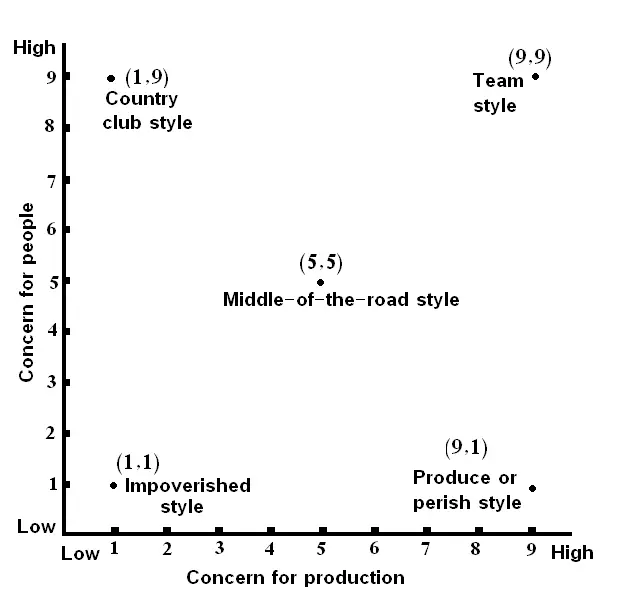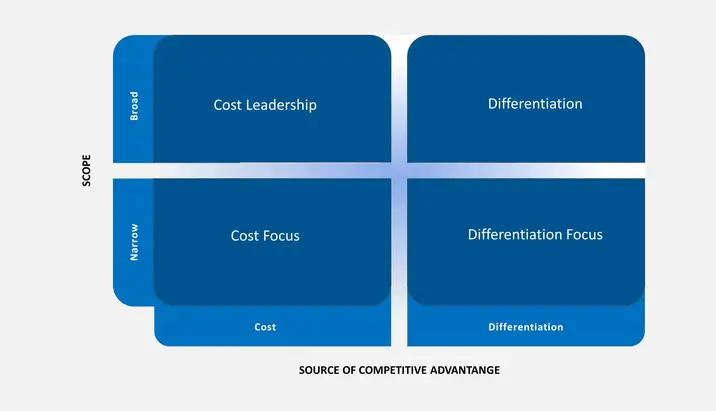Blake and Mouton Managerial Grid Theory | Leadership Style Grid
Blake and Mouton Managerial Grid Theory
Blake And Mouton Managerial Grid Theory is a popular model for thinking about leadership styles based on ‘task versus person’ orientation and was designed by Robert Blake and Jane Mouton in 1964. The model is often called the Leadership Grid or Managerial Grid. It plots the degree of task-centeredness (X-Axis) versus people-centeredness (Y-Axis) to identify five leadership combinations as distinct leadership styles.
The Blake and Mouton Managerial Grid came into existence when Blake and Mouton were hired as consultants by Exxon. They wanted to give a more nuanced picture of the leader than you get by using McGregor’s X and Y theory. It also differs from Tannenbaum Schmidt, who focused more on managers and subordinates’ power and decision-making level.
Robert Blake and Mouton develop this theory in 1964, and it considers the focus of managers when leading an organization, whether it’s on people or task.
Robert Blake and Mouton generated a grid that scales from 1-9 in terms of focusing on the task and focusing on people shown below. When deciding how best to accomplish a task, the two axes are both numbered from 1 to 9. Where one is low, and nine is high.

The leader’s concern for production is placed on the X-axis and the second dimension is concerned for people, also sometimes called staff; it is placed on the Y-axis.
The leader is placed in the managerial grid, and it takes into account only two dimensions.
- Concern for Production/ Task
- Concern for People
Concern for Production Leadership
Concern for Production/ Task refers to the degree to which a leader emphasizes concrete objectives organizational efficiency on high productivity when deciding how best to accomplish a task.
Therefore the focus here could be radically planned objectives, strategies, and processes that they’re trying to fulfill.
You could also think about this as one great big planning book where they’re following; Corporate plans, detailed steps, and processes using tools like Critical Path analysis, the processes involved in having very clear aims, and objectives measured in terms of Key Performance Indicators.
💥🎁 New Year & Easter Deals On Amazon !
Don't miss out on the best discounts and top-rated products available right now!
🛒 Shop Now and Save Big Today!*As an Amazon Associate, I earn from qualifying purchases.
Concern for People Leadership
Concerned for people refers to the degree to which a leader considers team members’ needs, interests, and personal development areas.
Richard Branson has very famously questioned the idea of consumer sovereignty, about consumers being king that the fact they should come first with any organization.
Branson champion the fact that employees of the most important stakeholders, with the logic being happy employees mean happy customers, which ultimately happy shareholders.
While the suggests focus on people is important, obviously there are times when focusing on the people, but not the task can be counterproductive.
Blake and Mouton Managerial Grid 5 Leadership Styles
Blake and Mouton defined five leadership styles.
The five stars are located in;
- Leadership Style Grid 1 9 (Country Club Leadership)
- Leadership Style Grid 9.1 (Produce or Perish Leadership)
- Leadership Style Grid 1 1 (Impoverished Leadership
- Leadership Style Grid 5.5 (Middle of The Road Leadership)
- Leadership Style Grid 9.9 (Team Leadership)

Management Grid
Country Club leadership (Leadership style 1.9)
Country Club leadership has low concern for production and high concern for people.
This style of leader is most concerned about the needs and feelings of members of his team. These people operate under the assumption that as long as team members are happy and secure, then they will work hard.
With no real plans and strategies in place, no meaningful work is done. The manager may be very focused on looking after the team, but not really on any level of productivity.
Again, this is not going to really productive area to been. Abraham Maslow would suggest social needs being met, but it’s not an interesting job.
💥🎁 New Year & Easter Deals On Amazon !
Don't miss out on the best discounts and top-rated products available right now!
🛒 Shop Now and Save Big Today!*As an Amazon Associate, I earn from qualifying purchases.
What tends to result in a work environment that is very relaxed and fun but where production suffers due to lack of direction on control, a typical statement from a country club leader is;
It should always be fun to go to work.
Produce or Perish leadership (Leadership style 9.1)
Produce or Perish leadership is also called as authoritarian or compliance leaders. They have a high concern for production and low concern for people and is the reverse of the previous leadership style 1.9
Leaders in this category believe that employees are simply a means to an end. Employee needs are always secondary to the need for efficient and productive workplaces.
The style you might associate with this is a military-style where it is very clear goals and objectives that we are trying to achieve. But actually, the focus is not very much on the staff or their particular well-being.
Often this style is appropriate whenever there’s some form of crisis, and we need an autocratic and clear style of leadership needs to be adopted.
This can link this directly with Douglas McGrath, who suggested this style on theory X for the leader gives very little respect to employees, doesn’t necessarily want to involve them.
This type of leader is very autocratic, has strict work rules, policies on procedures, and views, punishment as the most effective means to motivate employees.
A typical statement from a parish leader is;
Do as you are told, or you are fired.
Impoverished leadership. Leadership style 1.1
Impoverished leadership style has low concern for production and low concern for people. This leader is mostly ineffective. He has neither a high regard for creating systems for getting the job done nor for creating a work environment that is satisfying on motivating. He doesn’t care.
This is where there’s no focus on the task. There is no focus on people, and essentially, the leaders abdicate. There’s no clear pathway. No strategies are moving forward, and employees don’t seem to be enforced.
💥🎁 New Year & Easter Deals On Amazon !
Don't miss out on the best discounts and top-rated products available right now!
🛒 Shop Now and Save Big Today!*As an Amazon Associate, I earn from qualifying purchases.
In essence, you could say here that our leaders are very much hiding under the table. They don’t get involved there, worry perhaps their own job security; therefore, they don’t instigate any new task, any new plans, and strategies because if they go wrong, there were the ones held to account.
A result is a place of disorganization, dissatisfaction, and disharmony. The leadership is type creates a very bad atmosphere amongst the staff. The staff does not get any feedback about their work or themselves.
A typical comment from the staff is;
Is he our leader? I thought it was a guest appearance.
Middle of the road leadership -Leadership style 5.5
Middle of the road leadership has a medium concern for production and medium Concern for People.
This style seems to be a balance of the two competing concerns. It may at first appear to be an ideal compromise; therein lies the problem when you compromise…
This is where a leader will be making some compromises in terms of how the organization is run. They won’t be focusing fully on the task as they’re worried about doing so may detract from the staff and their wellbeing unequally. They won’t focus fully on people as they want to get the task done.
Probably a weak leader, and actually, this is not a great place to be. You necessarily give away a bit of each concern so that neither production nor people’s needs are fully met.
Leaders who use this style settle for average performance and often believe that this is the most anyone can expect. It all gets a bit stuck in the middle. Not good, but not too bad.
It’s an okay place to work, and we produce an okay product. We belong in every way to the gray masses.
You must, as a leader, never accept this position. A leader in 5.5 has to try to move towards 9.9
Team leadership- Leadership style 9.9
Team leadership has a high concern for production and high concern for people.
💥🎁 New Year & Easter Deals On Amazon !
Don't miss out on the best discounts and top-rated products available right now!
🛒 Shop Now and Save Big Today!*As an Amazon Associate, I earn from qualifying purchases.
According to the model, this is the pinnacle of managerial style. These leaders stress production needs and the needs of people equally highly.
That’s where we have a high focus on the task and people and team being productive. This could be very transformational. It may be the fact McGregor we’re thinking more of Theory Y and employees being heavily involved but actually got a real clear strategy and ideas moving forward, an innovative company that wants progress and perhaps lead this market.
The promise here is that employees are involved in understanding the organizational purpose and determining production needs.
When employees are committed to and have a stake in the organization’s success, their needs and production needs coincide.
This creates a team environment based on trust and respect, which leads to high satisfaction on motivation and, as a result, high production.
A typical statement from a team leader is;
I trust in my staff, they will make the right decisions.

Blake and Mouton Managerial Grid Example
Applying the Blake and Mouton managerial grid to yourself.
Think of some recent situations where you were the leader. For each of these situations, place yourself in the grid according to where you believe you fit. Now, look critically at the results of these management situations.
Should you work more with concern for people or with concern for production to move towards Leadership Grid Style 9.9?
- If you are high in concern for production and low in concern for people, you need to work on both communications with your staff and your staff’s involvement.
- If you are high in concern for people and low in concern for production, then you need to draw up work plans for both your staff on yourself.
- If you are in 5.5 middle of the road, you must challenge yourself and your team to move towards 9.9.
Criticism of Blake and Mouton Managerial Grid Theory
- There are situations where 9.9 is not optimal. If your company is in the midst of a takeover of another company and your staff are uncertain about their future, then it is probably necessary that you show more concern for people than concern for production.
- Conversely, if the company is in financial difficulties, you have to be more concerned for production than concern for people, at least until the crisis is over.
- The opportunistic or, for that matter, the psychopathic leader does not fit into the model. This type of leader manipulates staff and lies about production results if it serves its purpose. He has never focused on concern for production or concern for people. They are used to promote his personal goals.




